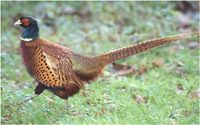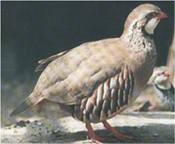Pheasants There are over 50 species of ornamental pheasants, ranging from the highly colourful Golden Pheasant to the flamboyant Eared Pheasants, not forgetting the more endangered Tragopans to Pavo cristatus, the proud and spectacular peacock. Most of these are kept as pairs or trios in aviaries. Some species are subject to CITES (Convention in International Trade in Endangered Species) Appendices, needing certain conditions for acquisition. If overhead netting is not available for a larger area, pheasants can have both wings clipped leaving the outer two or three primaries so they can glide down from having climbed a tree. Since their primaries are replaced at different times as they moult over an extended period, they must be checked regularly. They are not blessed with the largest of brains, however, and require protection from glass windows and vehicles. Some species of pheasant such as the grouse, the Eared and the Tragopans tame well but most of them, including partridges, remain nervous and wild, flying upwards at the first sign of perceived danger, so soft netting as an aviary roof is a sensible precaution. It is illegal to release non-indigenous species into the wild.
Some of the species get the flamboyant male colouring at twelve months old and some at 3 years. Incubation times vary with species but the range is 24-28 days. Game PheasantsGame Pheasant (Phasianus colchicus) The Ringneck or Game pheasant is reared and released on to farmland and woods all over the UK in summer for shooting from 1st October to 1st February. Several millions of birds are reared and shooting and game meat is worth £2 billion to the UK economy.
Redleg Partridge (Alectoris rufa) The redleg partridge is reared and released similarly to the game pheasant (season opens on 1st September) but in smaller numbers, mostly in the flat and dry lands of East Anglia. The grey or English partridge (Perdix perdix) is our native bird and the centre of much conservation activity all over the UK. Due to disease control, most pheasants and redleg partridges are kept and reared on game farms, then transported to shoots at around 6-8 weeks old. Some estates used to get breeding stock of game pheasants and redleg partridges by catching up from the woods before the end of the shooting season and enclosed in breeding pens. Eggs are collected, incubated (the breeding stock is then released) and the poults reared to 6 weeks before being put into large release pens in woods in summer. Nearly all the game shot goes into the food chain and is a popular dish in restaurants and the home. Vermin (crows, mapgies, foxes) is controlled on shooting estates (in England although recently restricted in Wales and Scotland) and thus predation is minimized and the habitat is enhanced for farmland and woodland birds which also benefit from sharing the pheasants’ feed in winter. Diseases Flubenvet is given in-feed to counteract intestinal worms at release and acidifying agents (e.g. cider vinegar) put in the water to discourage bacteria and harmful protozoa. |








